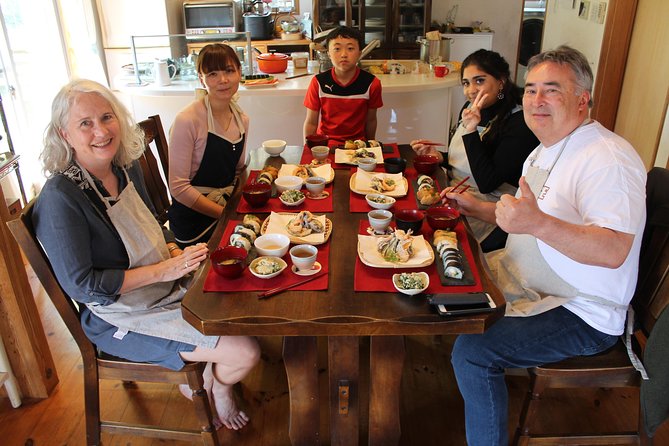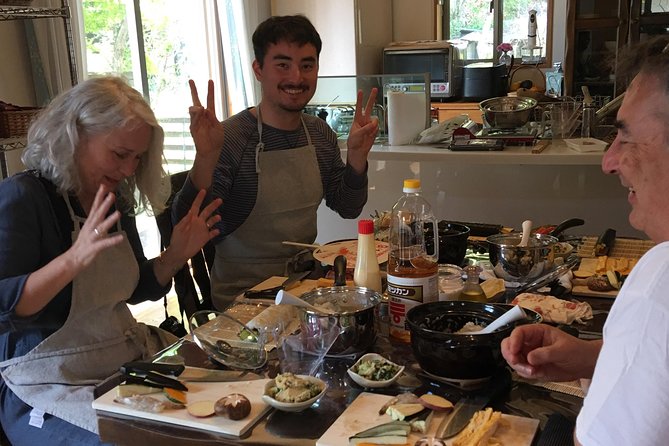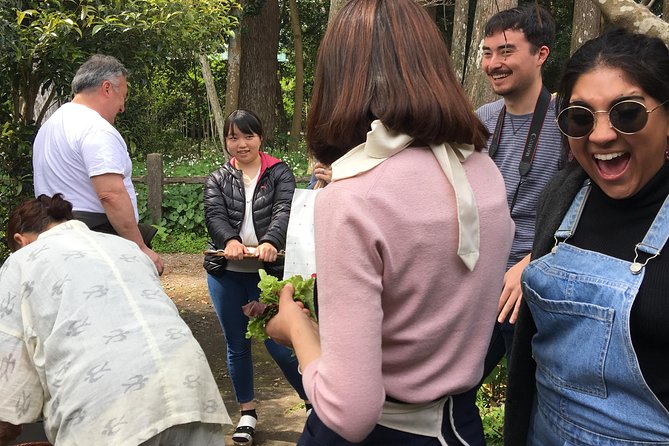In a recent survey, it was found that a significant number of individuals have shown an increasing interest in learning how to prepare Japanese cuisine at home. The intricate flavors and cultural significance of dishes like sushi, tempura, and gyoza have captured the attention of foodies worldwide.
But how can one truly recreate these authentic flavors in their own kitchen? By uncovering the secrets of traditional Japanese cooking techniques and ingredients, aspiring chefs can embark on a culinary adventure that transcends borders and tantalizes taste buds.
Key Points

- Learn authentic Japanese cooking techniques hands-on.
- Understand ingredient importance for quality dishes.
- Gain personalized instruction from experienced chefs.
- Acquire skills to recreate Japanese dishes at home.
Menu Options for Japanese Cooking

When considering Japanese cooking at home, an array of menu options awaits, including sushi, tempura, bento lunch boxes, gyoza, soup, and okonomiyaki.
Ingredient variations play a crucial role in these dishes, offering a diverse range of flavors and textures. For sushi, ingredients like fresh fish, rice, and seaweed are common staples, whereas tempura utilizes a light batter for frying seafood and vegetables.
Bento lunch boxes showcase ingredient variety with rice, meat or fish, and pickled vegetables neatly arranged. Gyoza, a type of dumpling, combines ingredients like ground meat and cabbage, while okonomiyaki, a savory pancake, allows for customizable ingredient combinations.
Cooking techniques such as sushi rolling, tempura frying, bento box assembly, gyoza folding, and okonomiyaki flipping add depth to the culinary experience.
Meeting and Pickup Details
For convenient access to the Japanese food cooking experience at home, participants can arrange for pickup service at Miyazaki station. Transportation logistics are made easy with this local pickup arrangement, ensuring a smooth start to the culinary adventure.
Detailed instructions for driving to the house will be provided for those opting to drive themselves. The pickup service from Miyazaki station adds an extra layer of convenience, especially for those unfamiliar with the area. By offering this service, the hosts aim to make the journey to the cooking location hassle-free.
Participants can rest assured that the meeting point at Miyazaki station is a convenient starting point for this exciting cooking experience.
Activity Details for Japanese Cooking

To enhance the Japanese cooking experience, participants can look forward to a personalized and interactive session that immerses them in the art of preparing traditional dishes.
What Participants Can Expect:
-
Hands-On Experience: Engage in learning authentic Japanese cooking techniques such as slicing sashimi, rolling sushi, or mastering the art of tempura frying.
-
Ingredient Sourcing: Discover the importance of fresh and high-quality ingredients in Japanese cuisine, with insights on where to find these items locally.
-
Interactive Guidance: Receive personalized instruction from experienced chefs who’ll guide participants through each step of the cooking process, ensuring a rewarding and educational experience.
Participants will leave the session equipped with newfound skills and knowledge to recreate delicious Japanese dishes at home.
Pricing and Reviews Information

Delving into the pricing and reviews section unveils valuable insights into the cost and overall customer satisfaction of this Japanese cooking experience. The price for this culinary adventure starts from $78.88, ensuring that it offers value for money. With a lowest price guarantee, participants can enjoy the activity without breaking the bank.
The reviews paint a glowing picture, with an impressive 5.0 rating based on 10 reviews. This breakdown includes feedback from customers who awarded 5 stars down to 1 star, showcasing a range of opinions. Customer satisfaction seems to be high, indicating that this Japanese cooking opportunity is well-received and worth considering for those looking to explore the culinary delights of Japan from the comfort of their own home.
Cancellation Policy for Japanese Cooking

Exploring the Japanese cooking experience further, insights into the cancellation policy reveal important guidelines for participants to be aware of regarding potential changes or adjustments to their scheduled activity. When booking a Japanese cooking class, individuals should take note of the following points:
-
Non-refundable experience: Understand that most Japanese cooking classes have a non-refundable policy in place, emphasizing the commitment required upon booking.
-
Weather-dependent cancellations: Be aware that some classes may be subject to weather conditions, leading to potential cancellations for safety reasons.
-
Learn more about cancellations: Familiarize yourself with the specific cancellation procedures of the cooking class you choose, ensuring you know the steps to take if you need to make changes to your reservation.
Common questions

What Are Some Common Ingredients Used in Japanese Cooking at Home?
Common ingredients in Japanese cooking at home include rice, soy sauce, mirin, dashi, and miso. These staples are essential for traditional Japanese dishes. Quick recipes like sushi, tempura, and ramen often rely on these flavors and pantry items.
Are There Any Traditional Japanese Cooking Techniques That Beginners Should Be Aware Of?
Beginners should know traditional Japanese cooking techniques like simmering, grilling, and steaming. These methods enhance flavors and textures. Tips include mastering the art of dashi broth, precise knife skills, and understanding the importance of umami-rich ingredients for authentic dishes.
How Can I Find Authentic Japanese Recipes to Try at Home?
To find authentic Japanese recipes to try at home, one can explore Japanese street food and culinary traditions. Look for quick recipes and fusion cuisine that blend traditional flavors with a modern twist for a delightful cooking experience.
Are There Any Specific Kitchen Tools or Utensils That Are Commonly Used in Japanese Cooking?
Japanese kitchen tools and essential utensils include a rice cooker, sushi mat, sharp chef’s knife, and bamboo steamer. These items are commonly used in Japanese cooking to prepare traditional dishes like sushi, tempura, and ramen.
What Are Some Tips for Creating a Well-Balanced Japanese Meal at Home?
To create a well-balanced Japanese meal at home, focus on portion control, incorporate umami flavors, use seasonal ingredients, and apply proper plating techniques. This ensures a harmonious blend of taste, nutrition, and visual appeal.
Last Words

Set out on a culinary adventure and bring the flavors of Japan into your own kitchen with a Japanese food cooking experience at home.
From sushi to tempura, bento boxes to okonomiyaki, there’s something for every palate to enjoy.
With convenient meeting and pickup services, detailed activity instructions, and valuable pricing and reviews, you’ll be well-equipped to create delicious Japanese dishes with ease.
Don’t miss out on this opportunity to elevate your cooking skills and learn about the art of Japanese cuisine.

